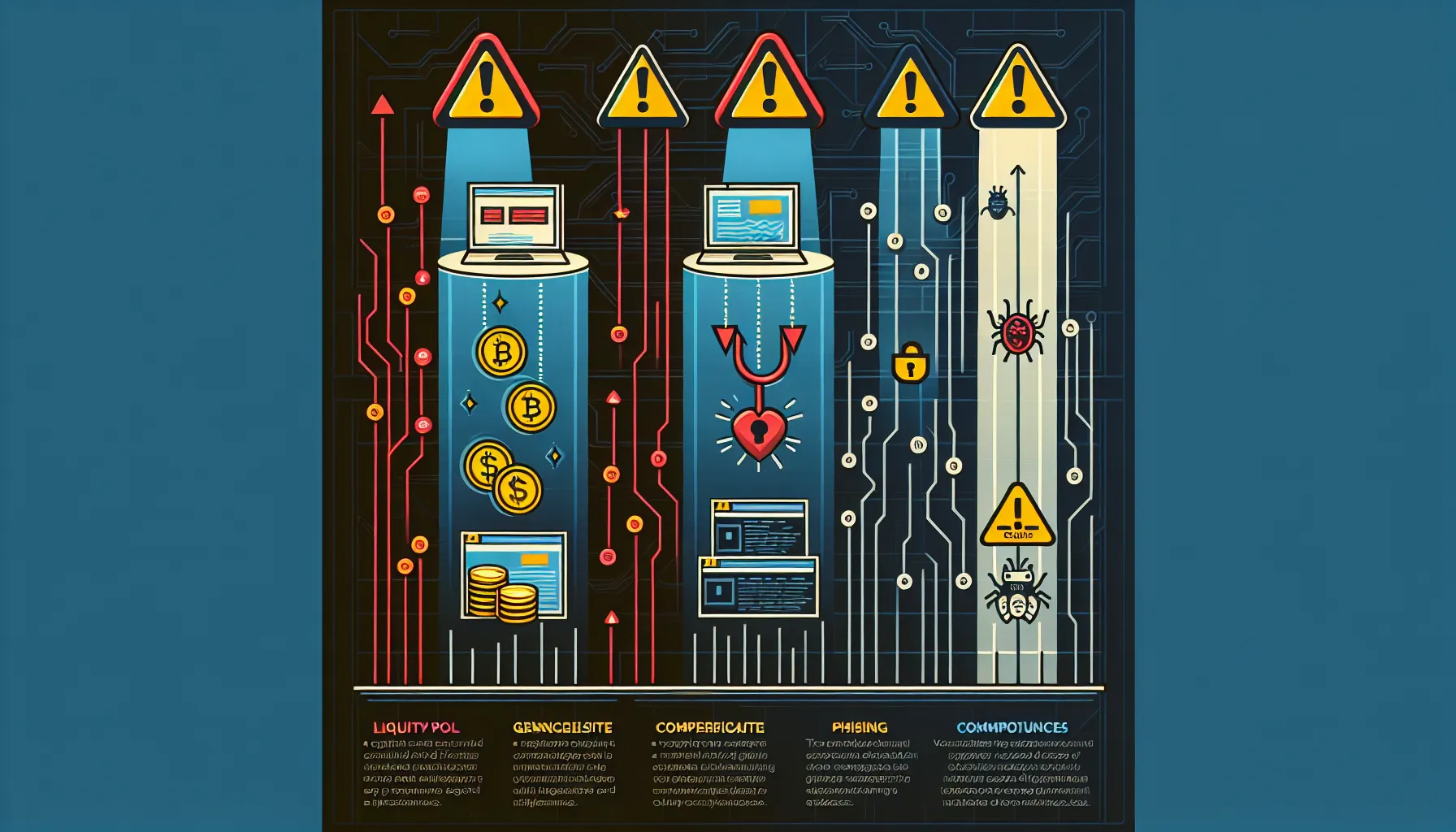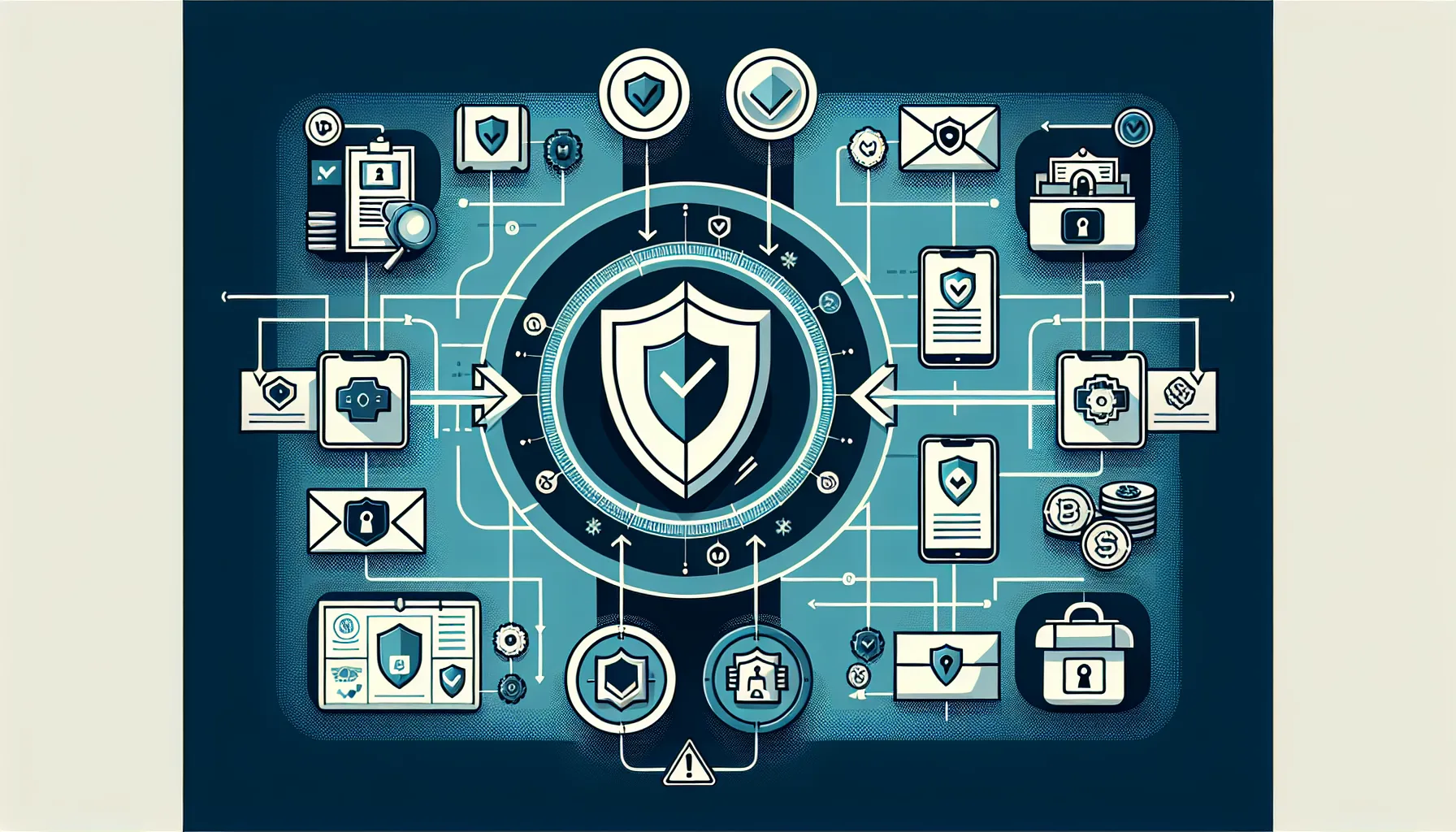Decentralised Finance (DeFi) has revolutionised the financial landscape by offering anyone with an internet connection direct access to lending, borrowing, trading, and yield farming, without intermediaries. Yet this openness comes with a dark side. The same lack of oversight that makes DeFi attractive also creates fertile ground for scammers, fraudsters, and hackers. In 2024 alone, billions were lost to DeFi exploits, rug pulls, and phishing attacks, leaving countless users nursing heavy losses and shattered trust.
But it doesn’t have to be this way. With the right knowledge and a cautious approach, users can navigate DeFi safely and enjoy its benefits without falling victim to scams. This guide breaks down the most common DeFi threats, the security measures every user should adopt, and practical steps for researching projects, spotting red flags, and executing transactions safely. Whether someone is a DeFi newcomer or a seasoned trader, understanding these principles is essential for protecting their assets in this rapidly evolving space.
Key Takeaways
- Understanding common DeFi scams like rug pulls, phishing attacks, and smart contract exploits is essential for protecting your assets in decentralised finance.
- Always verify smart contract audits from reputable firms and use hardware wallets to safeguard significant holdings when using DeFi platforms.
- Thorough research into team transparency, liquidity depth, and trading volume helps users identify legitimate projects and avoid scams.
- Red flags such as unrealistic returns, anonymous teams with poor documentation, and high-pressure tactics indicate potential DeFi scams.
- Starting with small transaction amounts and double-checking all details before confirming prevents costly mistakes on DeFi platforms.
- Leveraging security tools like transaction analysers and blockchain explorers provides ongoing protection whilst navigating DeFi safely.
Understanding the Most Common DeFi Scams

Before diving into DeFi, users must understand the types of scams that plague the ecosystem. Awareness is the first line of defence, and recognising these threats can mean the difference between profit and catastrophic loss.
Rug Pulls and Exit Scams
Rug pulls are among the most devastating DeFi scams. They occur when developers create a seemingly legitimate project, attract investors, and then suddenly withdraw all liquidity from the project’s pools. This leaves investors holding worthless tokens that cannot be sold or exchanged. In many cases, the developers disappear entirely, taking users’ funds with them.
Exit scams follow a similar pattern but often involve more elaborate setups. Creators may spend weeks or months building trust, cultivating an active community, and even delivering on early promises before vanishing with the accumulated funds. The 2021 Squid Game token incident exemplifies this: the token surged to astronomical values before developers drained liquidity, leaving investors unable to sell.
These scams are particularly insidious because they exploit the decentralised, trustless nature of DeFi. Without centralised oversight, there’s often no recourse for victims. The key warning signs include locked liquidity timeframes that are suspiciously short, anonymous development teams, and projects that gain traction overnight without substantial backing or utility.
Phishing Attacks and Fake Websites
Phishing remains one of the most effective weapons in a scammer’s arsenal. In the DeFi context, attackers create counterfeit websites that closely mimic legitimate platforms. These fake sites may differ by just one letter in the URL or use slight variations that are easy to miss at a glance.
When users connect their wallets to these fraudulent sites, they’re often prompted to sign transactions that grant the attacker permission to drain their funds. Some phishing attacks arrive via email or social media, with messages claiming urgent security issues or exclusive opportunities that require immediate action.
The sophistication of these attacks has grown considerably. Scammers now use paid advertisements to ensure their fake sites appear at the top of search results, use SSL certificates to create a false sense of security, and even replicate social media accounts of legitimate projects. Users have lost substantial sums simply by clicking the wrong link or entering their seed phrase into a fake “wallet recovery” page.
Smart Contract Exploits
Smart contracts are the backbone of DeFi, but they’re also a potential vulnerability. These self-executing pieces of code can contain bugs, logic errors, or intentional backdoors that allow funds to be stolen. Even well-intentioned projects can harbour vulnerabilities that hackers exploit.
Some exploits are highly technical, taking advantage of complex interactions between different protocols (known as “flash loan attacks”). Others stem from basic coding errors that should have been caught during development. The 2022 Wormhole bridge hack, which resulted in a $320 million loss, demonstrated how a single vulnerability can have catastrophic consequences.
Malicious contracts are another concern. Scammers may deploy contracts with hidden functions that let them mint unlimited tokens, freeze user funds, or drain liquidity at will. These “honeypot” contracts may appear functional at first but prevent users from selling or withdrawing once they’ve invested.
Essential Security Measures Before Using Any DeFi Platform

Security in DeFi starts before anyone connects a wallet or deposits a single token. Implementing fundamental security measures dramatically reduces exposure to scams and exploits.
Verify Smart Contract Audits
A smart contract audit is an independent review conducted by security firms to identify vulnerabilities and verify that the code functions as intended. Reputable DeFi projects invest in audits from established firms like CertiK, Trail of Bits, OpenZeppelin, or ConsenSys Diligence.
But, an audit alone isn’t a guarantee of safety. Users should verify that the audit is recent, covers the contracts they’ll be interacting with, and addresses any identified issues. Some projects claim to be “audited” but only had a preliminary review or an audit of outdated code.
It’s also worth checking if the audit report is publicly available and reading through the findings. High-severity issues should have been resolved before launch. If a project cannot provide audit documentation or dismisses its importance, that’s a significant warning sign. Also, multiple audits from different firms provide stronger assurance than a single review.
Use Hardware Wallets for Large Holdings
Hardware wallets, physical devices that store private keys offline, represent one of the most effective defences against theft. Unlike software wallets, which are vulnerable to malware, phishing, and remote attacks, hardware wallets require physical access to authorise transactions.
For anyone holding substantial crypto assets or regularly interacting with DeFi, a hardware wallet from manufacturers like Ledger or Trezor is essential. These devices keep private keys isolated from internet-connected computers, meaning even if a user’s computer is compromised, their funds remain secure.
The best practice is to use hardware wallets for storing long-term holdings and larger amounts, whilst using a separate software wallet (with limited funds) for regular DeFi interactions. This approach limits potential losses if the software wallet is compromised. Users should also purchase hardware wallets directly from the manufacturer and verify the device hasn’t been tampered with upon arrival.
How to Research DeFi Projects Properly
Due diligence is non-negotiable in DeFi. The space moves quickly, and projects can emerge and disappear within days. Thorough research helps users separate legitimate platforms from elaborate scams.
Check Team Transparency and Track Records
Legitimate DeFi projects typically have identifiable team members with verifiable credentials and experience. Users should look for team information on the project website, LinkedIn profiles, GitHub activity, and previous projects the team has launched.
Anonymous or pseudonymous teams aren’t automatically disreputable, some successful DeFi projects have anonymous founders, but they do increase risk. If a team chooses anonymity, the project should compensate with exceptional transparency in other areas: open-source code, detailed documentation, active community engagement, and third-party audits.
Red flags include stock photos used for team member profiles, vague descriptions without specific expertise, and teams with no previous verifiable experience in blockchain or finance. A quick reverse image search can reveal whether “team members” are actually stock photos or stolen identities.
The team’s behaviour matters too. Are they responsive to community questions? Do they provide regular updates? Have they delivered on their roadmap promises? A team that overpromises and underdelivers, or that dismisses legitimate concerns, warrants extreme caution.
Analyse Liquidity and Trading Volume
Liquidity, the ease with which tokens can be bought or sold without significantly affecting price, is a crucial indicator of project health. Projects with low liquidity are more susceptible to price manipulation and make it difficult for users to exit positions.
Users should examine total value locked (TVL), daily trading volumes, and the number of liquidity providers. Sudden spikes in volume without corresponding news or development may signal wash trading or manipulation. Similarly, if a small number of wallets control most of the liquidity, those holders could remove their funds at any moment, crashing the market.
Platforms like DeFi Llama, DexScreener, and DexTools provide transparent data on liquidity depth, holder distribution, and trading patterns. Healthy projects show steady, organic growth rather than erratic spikes. Users should also check whether liquidity is locked, reputable projects often lock liquidity for extended periods to demonstrate commitment and prevent rug pulls.
Red Flags to Watch Out for When Choosing DeFi Platforms
Certain warning signs appear consistently across DeFi scams. Learning to recognise these red flags can prevent users from falling victim to fraudulent projects.
Unrealistic Returns and Promises
If a DeFi platform promises returns that seem too good to be true, they almost certainly are. Annual percentage yields (APY) of several thousand per cent are mathematically unsustainable and typically indicate a Ponzi scheme or a project destined to collapse.
Whilst DeFi can offer attractive yields compared to traditional finance, legitimate platforms provide realistic projections based on actual revenue sources: trading fees, lending interest, or protocol fees. Scam projects, by contrast, offer “guaranteed” returns or yields with no clear explanation of where the profits originate.
Users should be especially wary of projects that pressure quick decisions with claims of “limited-time” opportunities or exclusive access for early investors. This urgency is a classic manipulation tactic designed to bypass critical thinking. Legitimate projects don’t need high-pressure sales tactics, they let their technology and track record speak for themselves.
Anonymous Teams and Lacking Documentation
As mentioned earlier, anonymous teams increase risk. When combined with poor or non-existent documentation, this becomes a major red flag. Comprehensive documentation should include whitepapers, tokenomics explanations, technical architecture details, and clear use cases.
Projects with vague, jargon-filled whitepapers that don’t clearly explain how the protocol works or generates value are often scams. Similarly, if a project’s website is poorly designed, contains grammatical errors, or lacks professional presentation, it suggests the creators haven’t invested seriously in the platform.
Absence of a clear roadmap, lack of GitHub repository, or closed-source code (when transparency is expected) all indicate a project that doesn’t want scrutiny. In DeFi, transparency isn’t just preferable, it’s essential for trust and security.
Best Practices for Safe DeFi Transactions
Even with a vetted platform, individual transactions carry risk. Following best practices for each interaction minimises the chance of costly mistakes.
Start With Small Amounts
When testing a new DeFi platform, users should begin with minimal funds. This “pilot transaction” approach allows them to verify that the platform functions as advertised without risking substantial capital.
If the small transaction completes successfully, funds are deposited, yields accrue, withdrawals work properly, users can gradually increase their exposure. If something goes wrong, the loss is limited. This approach also helps users familiarise themselves with the platform’s interface and transaction flows before committing larger sums.
This principle applies to established platforms too. After a protocol upgrade or when interacting with a new smart contract feature, starting small provides insurance against unexpected bugs or changes.
Double-Check Transaction Details
Every blockchain transaction is irreversible. Once confirmed, there’s no “undo” button, no customer service to call, no way to reverse the transfer. This makes it absolutely critical to verify every detail before confirming a transaction.
Users should check the recipient address carefully, scammers sometimes use addresses that look similar to legitimate contracts. They should verify the amount being sent, the token type, and the estimated gas fees. Unusually high gas fees can indicate a problem with the transaction or an attempt to drain funds through excessive fees.
Many scams involve malicious approval requests that grant contracts unlimited access to a user’s tokens. Before signing any transaction, users must understand what they’re authorising. If unclear, it’s better to research or ask the community rather than proceeding blindly. Browser extensions like Pocket Universe or Fire can help decode transactions and warn users about suspicious activity.
Tools and Resources to Protect Yourself
The DeFi ecosystem has matured enough that numerous tools now exist to help users protect themselves. Taking advantage of these resources significantly improves security.
Reputable DeFi tracking platforms like DeFi Llama, DappRadar, and CoinGecko provide transparency into TVL, user counts, and project comparisons. These platforms aggregate data that would otherwise require visiting dozens of individual sites, making it easier to spot anomalies or compare projects side-by-side.
Browser extensions such as MetaMask’s security alerts, Pocket Universe, and Fire add transaction protection by analysing smart contract interactions in real-time and warning users about suspicious approvals or known scam addresses. These tools act as a second layer of defence when interacting with DeFi protocols.
Security-focused sites like Etherscan (for Ethereum) and BscScan (for Binance Smart Chain) allow users to verify smart contract code, check transaction history, and confirm that a contract address matches the official project documentation. Users should bookmark official links and always access platforms through verified URLs rather than search engine results.
Enabling multi-factor authentication (MFA) wherever possible adds another barrier against unauthorised access. Whilst most DeFi protocols don’t directly support MFA, email accounts and centralised exchange accounts that might serve as entry points should absolutely have MFA enabled.
Community resources matter too. Active communities on Discord, Telegram, or Reddit can provide real-time warnings about scams, share due diligence findings, and offer support when questions arise. But, users should be cautious: scammers also lurk in these spaces, often posing as support staff. Legitimate projects never ask for private keys or seed phrases.
Conclusion
DeFi represents a paradigm shift in how financial services can be accessed and used, but this innovation comes with risks that traditional finance has largely mitigated through regulation and oversight. In DeFi, users themselves must provide that oversight through vigilance, research, and disciplined security practices.
Understanding common scams like rug pulls, phishing attacks, and smart contract exploits forms the foundation of safe DeFi usage. From there, implementing essential security measures, verifying audits, using hardware wallets, creates robust defences. Thorough research into team transparency and liquidity, combined with awareness of red flags like unrealistic returns and poor documentation, helps users avoid scams before investing.
Safe transaction practices, including starting with small amounts and meticulously checking details, prevent costly mistakes. And leveraging available tools and community resources provides ongoing protection as the DeFi landscape evolves.
The reality is that DeFi will never be entirely risk-free. But users who approach it with informed caution, healthy scepticism, and a commitment to security can substantially reduce their exposure to scams whilst still participating in this transformative financial ecosystem. In DeFi, knowledge truly is the best protection, and that protection starts with understanding that if something seems too good to be true, it almost certainly is.
Frequently Asked Questions
What is a rug pull in DeFi and how can I avoid it?
A rug pull occurs when developers create a seemingly legitimate DeFi project, attract investors, then suddenly withdraw all liquidity, leaving users with worthless tokens. Avoid these by checking for locked liquidity, verifying team transparency, and being wary of projects with anonymous teams or overnight popularity.
How do I verify if a DeFi platform is safe to use?
Check if the platform has recent smart contract audits from reputable firms like CertiK or OpenZeppelin, verify team credentials and track records, analyse liquidity depth and trading volume, and look for transparent documentation. Start with small amounts to test functionality before committing larger sums.
Why should I use a hardware wallet for DeFi platforms?
Hardware wallets store private keys offline, protecting them from phishing attacks, malware, and remote exploits. For large holdings or frequent DeFi interactions, hardware wallets from manufacturers like Ledger or Trezor provide essential security since they require physical access to authorise transactions.
What are the warning signs of a DeFi scam?
Red flags include unrealistic APY returns of several thousand per cent, anonymous teams with poor documentation, pressure to invest quickly, vague whitepapers without clear revenue sources, and low liquidity controlled by few wallets. Stock photos for team members and lack of smart contract audits are also concerning.
Can smart contracts be hacked even if they’re audited?
Yes, audited smart contracts can still be vulnerable. Audits reduce risk but don’t guarantee complete security, as new exploits may be discovered or complex protocol interactions can create unforeseen vulnerabilities. The 2022 Wormhole bridge hack demonstrated how a single vulnerability can result in massive losses despite security measures.
What is the safest way to connect my wallet to DeFi platforms?
Always verify the official URL through multiple trusted sources and bookmark it, never click links from search results or unsolicited messages. Use browser extensions like Pocket Universe to analyse transactions before signing, double-check all transaction details including recipient addresses, and never share your seed phrase with anyone.



